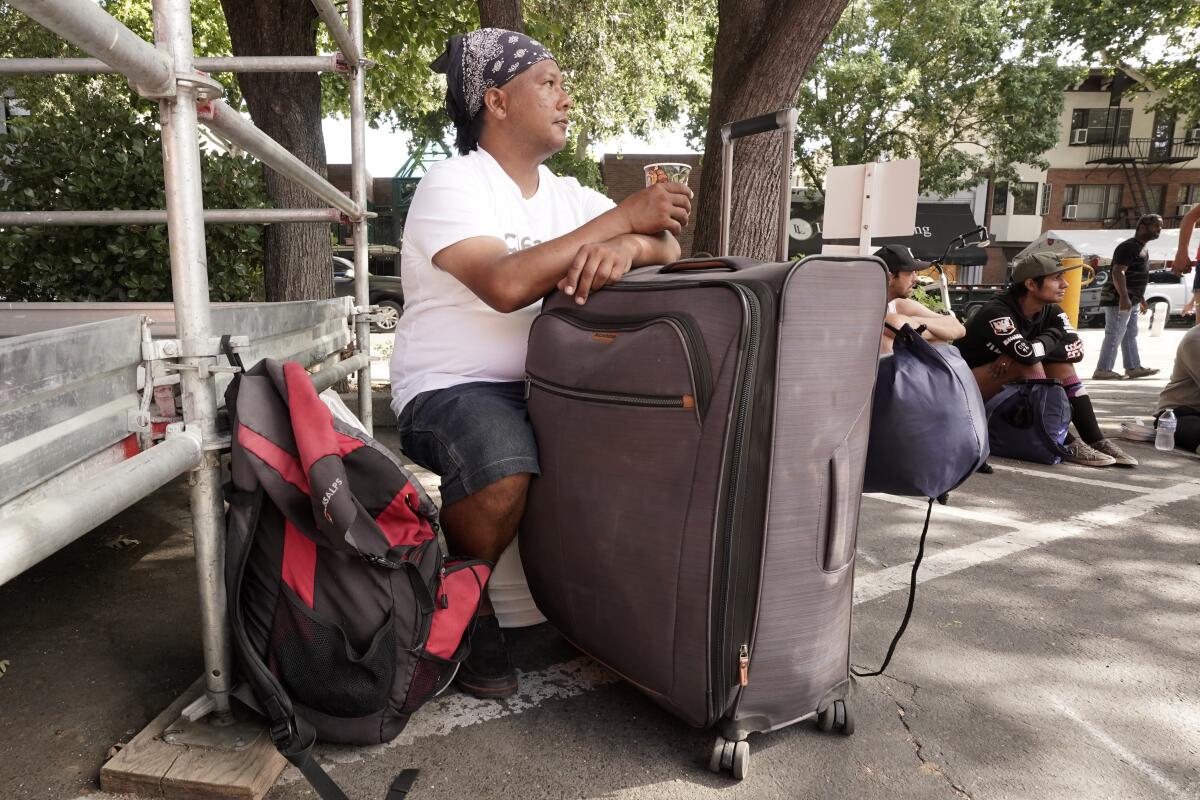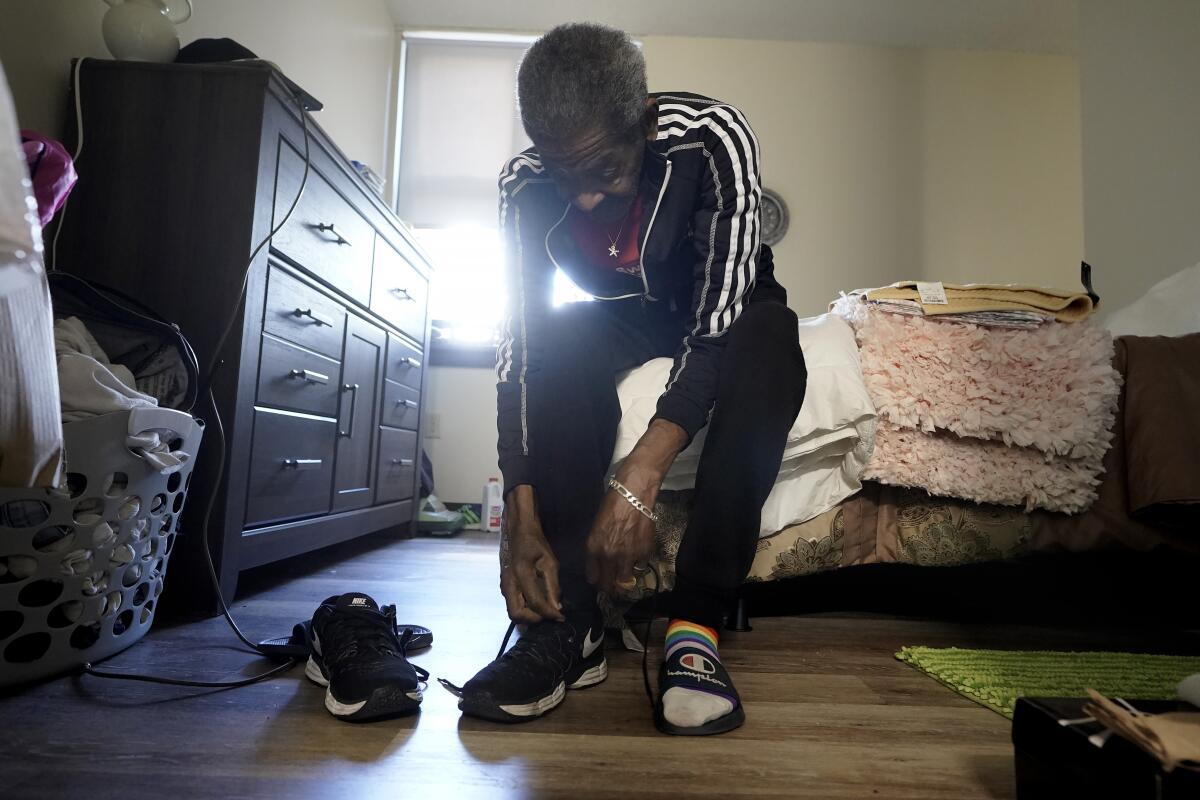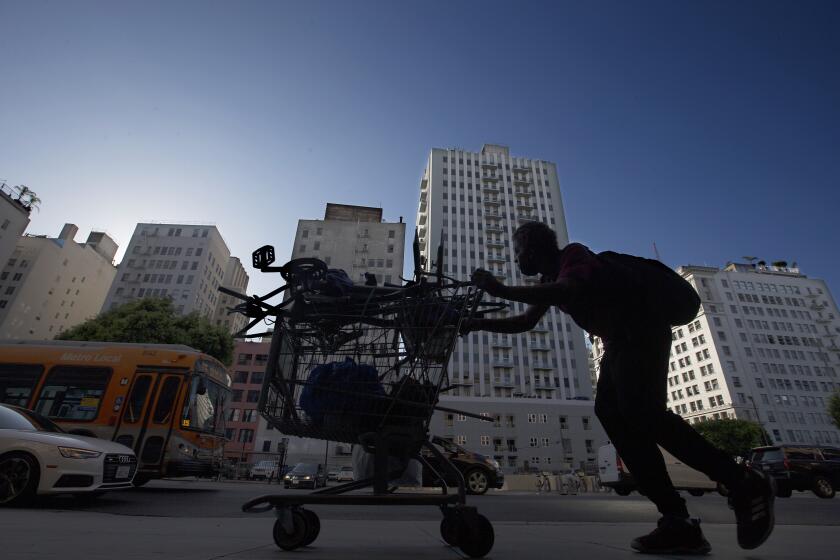Amid end to COVID help, homelessness surging in many cities

- Share via
SACRAMENTO — In California’s capital, massive tent encampments have risen along the American River and highway overpasses have become havens for homeless people, whose numbers have increased nearly 70% over two years.
Among the 9,300 without a home is Eric Santos, who lost his job at a brewery and was evicted from his apartment in July. Now he carries a list of places where free meals are available and a bucket to mix soap and water to wash his hands, and to sit on.
“The bucket is part of my life now,” the 42-year-old said, calling it his version of Wilson, the volleyball that becomes Tom Hanks’ companion in the film “Castaway.”
Cities big and small around the country are facing an experience similar to Sacramento’s.
Fueled by a long-running housing shortage, rising rents and the economic hangover from the COVID-19 pandemic, the overall number of homeless in a federal government report to be released in coming months is expected to be higher than the 580,000 unhoused before the coronavirus outbreak, the National Alliance to End Homelessness said.
The Associated Press tallied results from city-by-city “point in time” surveys this year and found the number of people without homes is up overall compared with 2020 in areas reporting results so far.
Come Feb. 1, Los Angeles landlords will again be able to evict tenants who are behind on their rent, the City Council decided.
Some of the biggest increases are in West Coast cities such as Sacramento and Portland, Ore., where growing homelessness has become a humanitarian crisis and political football. Numbers are also up in South Dakota, Prince George’s County in Maryland and Asheville, N.C.
Research has shown places seeing surges in homelessness often lack affordable housing. Making matters worse, pandemic government relief programs — including anti-eviction measures, emergency rental assistance and a child tax credit that kept people housed who may have been on the streets otherwise — are ending.
In Sacramento, where rents are soaring and officials disagree on how best to deal with the problem, homelessness has jumped 68% from 2020 to 2022 — the most among larger cities reporting results so far.
The surge has been driven in part by the city’s legacy of being more affordable than other California cities, which has attracted new residents and overwhelmed the housing market.
A Zillow analysis found the average rent in July was $2,300 — a 28% increase since July 2019, before the pandemic. Sacramento County’s median income was about $70,000 in 2020, according to the U.S. Census Bureau.
Evictions and rent increases still are limited in Los Angeles and many other parts of Southern California. But the rules vary from city to city.
Sacramento Mayor Darrell Steinberg has made reducing homelessness a priority since he took office in 2017. But it hasn’t been enough.
“People are becoming homeless much faster than we are getting them off the street,” he said.
Steinberg has advocated for adopting a legal right to shelter and a legal obligation for people to accept it when offered. The approach has drawn some criticism from advocates who say it’s just a means of taking the problem out of the public eye, without providing meaningful help for those who need it.
County officials voted in August to ban camping along Sacramento’s American River Parkway, with a misdemeanor charge for people who don’t comply. City voters will decide in November on a ballot measure requiring the city to open hundreds more shelter beds. But it would take effect only if the county agreed to pony up money for mental health and substance abuse treatment.
Still, the rise in homelessness is not uniform across the country.
In Boston, the number of people sleeping on the streets and in shelters has dropped 25% over two years as advocates focused on finding permanent housing for those on the streets the longest.
In some cities, “housing first” policies intended to move the homeless into permanent homes have paid off. The pandemic brought economic chaos, but an eviction moratorium, boosted unemployment payments and family tax credits prevented some people from becoming homeless at all.
Along with Boston, numbers have fallen sharply in Houston, Philadelphia and Washington, D.C. Even in California, homeless counts are down in San Francisco, and growth has slowed significantly in Los Angeles.
The rate at which L.A. County’s homeless population grew slowed over the last two years in part because of the pandemic, a homeless count shows.
In Boston, Steven Hamilton moved into a new apartment in September after decades staying on a friend or relative’s couch or in a homeless shelter.
With the help of a program run by the Boston Medical Center, he was able to get a subsidized apartment in a public housing development. His portion of monthly rent is $281 — or about 30% of his Social Security payments.
“I’m grateful,” he said. “I am not looking to move nowhere else. I am going to stay here until eternity. I lost a lot of stuff. I’m not going through that again.”

Hamilton’s studio apartment is the result of a Boston strategy whereby the city and area nonprofits use extensive outreach to get people who’ve been on the streets for over a year into apartments and then provide services such as drug treatment and life-skills training like budgeting.
Those efforts were bolstered last year by a city program that pulled together a list of homeless individuals to target for housing and other services. The city also moved to shut down one of its biggest encampments, going tent to tent to assess the needs of those living there and referring more than 150 to shelters and other housing.
The city has been able to reduce the number of homeless people to about 6,000, down 25% since 2020.
Boston’s shelters have become less crowded even as Zillow found the city’s average rent rose to $2,800 this summer — up 13% from three years earlier.
Housing advocates say prioritizing chronically homeless people ensures funds have the greatest impact, since the long-term homeless spend so much time in shelters. It also costs less to provide permanent housing than to provide temporary shelter.
Casey reported from Boston. Mulvihill reported from Cherry Hill, N.J. Kavish Harjai in Los Angeles contributed to this report. Harjai is a corps members for the Associated Press/Report for America Statehouse News Initiative. Report for America is a nonprofit national service program that places journalists in local newsrooms to report on undercovered issues.
More to Read
Sign up for Essential California
The most important California stories and recommendations in your inbox every morning.
You may occasionally receive promotional content from the Los Angeles Times.
















